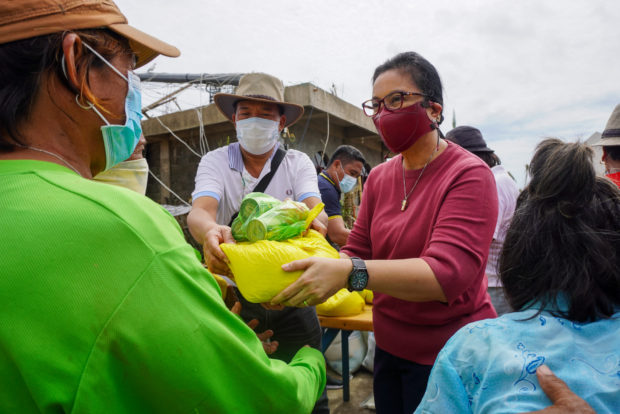Robredo says Dep’t of Disaster might be ‘unnecessary’ level of bureaucracy

Vice President Leni Robredo visits the province of Catanduanes on November 3, 2020, as her office continues its relief efforts for areas affected by Super Typhoon Rolly in the Bicol Region. Photo from the Office of the Vice President.
MANILA, Philippines — Vice President Leni Robredo has expressed skepticism over proposals to create a Department of Disaster that would address calamities in the country, saying that it might only add an unnecessary level of bureaucracy.
Robredo explained on Monday that there already exists a government agency that would address these issues, and that is the National Disaster Risk Reduction Management Council (NDRRMC).
She said it should first be assessed if there is really a need to set up a new department to address these concerns.
“Mayroon kasi tayong NDRRMC, […] under Office of Civil Defense. Ako, iyong sa akin, it is worth studying pero i-assess muna [kung] kailangan ba talaga, ano iyong kakulangan ng present set-up na kinakailangan pa nating gumagawa ng another department,” Robredo told ABS-CBN News Channel’s Headstart.
(We already have the NDRRMC under the Office of Civil Defense. For me, it is worth studying but we should assess first what is needed in the present set-up, and why we need to create another department.)
Article continues after this advertisement“Kasi iyong mahirap, kung ang solusyon natin parati lang kapag may problema, magbubukas ng bagong disaster [department]. Baka nagke-create lang tayo unnecessary ng many levels in the bureaucracy,” she added.
Article continues after this advertisement(Because what’s difficult is that when we always think we can solve problems by opening a new disaster department, we might just create many unnecessary levels in the bureaucracy.)
Robredo further said that instead of creating a new department, the government can consider fixing problems within NDRRMC or strengthening the institution itself through amendments or legislation.
“Nagbubukas ng bagong agency na mayroon namang existing. So baka it would be worth studying iyong existing agency kung ano ba iyong kakulangan nito. Ano ba iyong kakulangan ng existing agency para kung may kulang, baka kaya naman ng legislation,” she noted.
(Why open a new agency when you have one existing. So maybe it would be worth studying what the existing agency lacks. What are its shortcomings so we can address them, maybe through legislation.)
Many of the administration’s allies including Senator Bong Go — President Duterte’s former aide — have been proposing the establishment of a Department of Disaster, to allow this specific agency to focus on calamities.
Talks about the proposed department came to life again after the country was rocked by succeeding storms — eight in just a month’s time. Out of these, several cyclones like Typhoon Quinta and Super Typhoon Rolly, and most recently Typhoon Ulysses, brought widespread destruction in Luzon.
The Philippines, with its position in the Pacific ring of fire, faces an average of 20 cyclones per year, and has been prone to volcanic eruptions and earthquakes.
In 2019, Mindanao experienced a number of moderately strong earthquakes, while just this January, Taal Volcano erupted and covered several provinces in thick ash.
But President Duterte himself admitted on Sunday that the Department of Disaster bill is facing tough opposition in Congress, as a lot of people believe it is not necessary.
Robredo has been active as of late with responding to natural calamities after Rolly barreled into her hometown Camarines Sur, Albay, and Catanduanes in Bicol; and after Ulysses brought immense floods in Marikina, Rizal, and Cagayan Valley.
Last Friday, Robredo started coordinating with various teams from the Armed Forces of the Philippines (AFP) to facilitate the rescue of Cagayan Valley residents trapped due to flooding. On Sunday, she and Duterte went to several areas in the said region to personally check the state of the people.
Flooding in Cagayan Valley stemmed from the Magat Dam’s release of waters, as it was already nearing critical level due to Ulysses and previous storms.
The Philippine Atmospheric, Geophysical and Astronomical Services Administration (Pagasa) data last Friday showed that Magat Dam — located at the Magat River which is a major tributary of the Cagayan River — had an outflow of 5,073 centimeters.